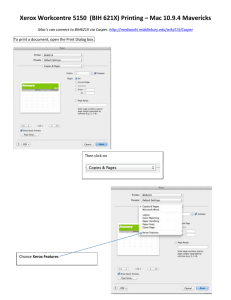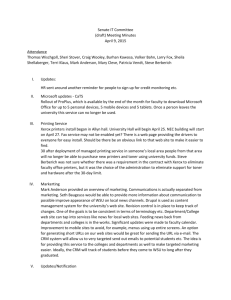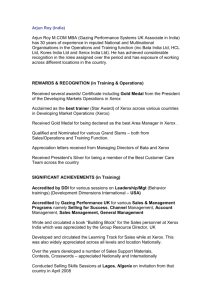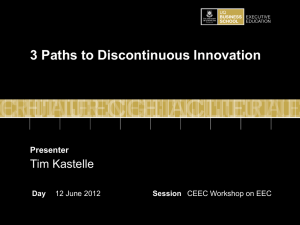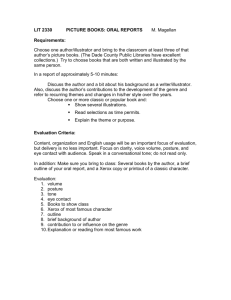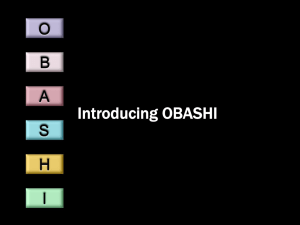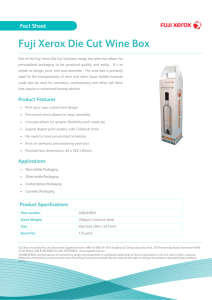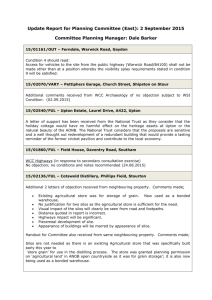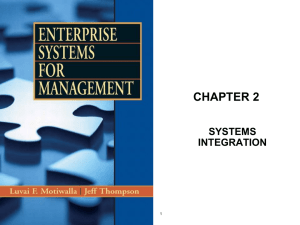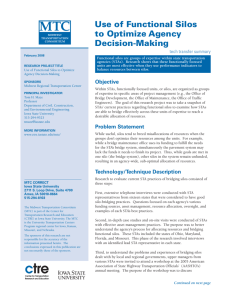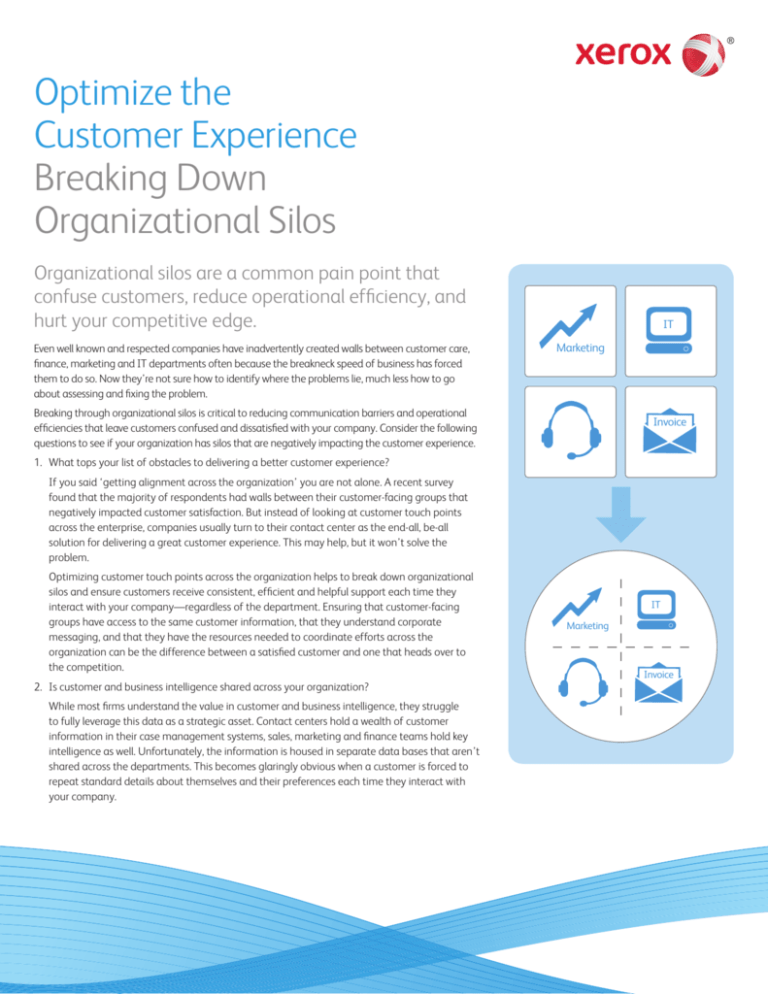
Optimize the
Customer Experience
Breaking Down
Organizational Silos
Organizational silos are a common pain point that
confuse customers, reduce operational efficiency, and
hurt your competitive edge.
Even well known and respected companies have inadvertently created walls between customer care,
finance, marketing and IT departments often because the breakneck speed of business has forced
them to do so. Now they’re not sure how to identify where the problems lie, much less how to go
about assessing and fixing the problem.
IT
Marketing
Breaking through organizational silos is critical to reducing communication barriers and operational
efficiencies that leave customers confused and dissatisfied with your company. Consider the following
questions to see if your organization has silos that are negatively impacting the customer experience.
Invoice
1.What tops your list of obstacles to delivering a better customer experience?
If you said ‘getting alignment across the organization’ you are not alone. A recent survey
found that the majority of respondents had walls between their customer-facing groups that
negatively impacted customer satisfaction. But instead of looking at customer touch points
across the enterprise, companies usually turn to their contact center as the end-all, be-all
solution for delivering a great customer experience. This may help, but it won’t solve the
problem.
Optimizing customer touch points across the organization helps to break down organizational
silos and ensure customers receive consistent, efficient and helpful support each time they
interact with your company—regardless of the department. Ensuring that customer-facing
groups have access to the same customer information, that they understand corporate
messaging, and that they have the resources needed to coordinate efforts across the
organization can be the difference between a satisfied customer and one that heads over to
the competition.
2. Is customer and business intelligence shared across your organization?
While most firms understand the value in customer and business intelligence, they struggle
to fully leverage this data as a strategic asset. Contact centers hold a wealth of customer
information in their case management systems, sales, marketing and finance teams hold key
intelligence as well. Unfortunately, the information is housed in separate data bases that aren’t
shared across the departments. This becomes glaringly obvious when a customer is forced to
repeat standard details about themselves and their preferences each time they interact with
your company.
IT
Marketing
Invoice
Identifying and eliminating communication barriers that prevent customer intelligence from
being shared can help measurably boost sales, revenue, customer acquisition and retention.
Having access to the same information is instrumental to managing the overall customer
relationship. Interactions become seamless to the customer regardless of the channel used or
the department.
3. What is your cross-functional communication strategy?
Often customers receive a different message depending on the touch point they use to engage
with your company. Conversations with a salesperson can differ significantly than the message
customers hear when they call the contact center or engage a representative on social
media channels. Without question, it’s a difficult task to ensure all employees understand the
messaging and are delivering it consistently to customers.
Managing isolated operations is not enough ensure customers receive a consistent message
and an optimized experience at every touch point with your organization. Instead, using
comprehensive assessments and analysis of customer feedback will help pinpoint where the
communication gaps and information black holes exist across the organization. The insight
gained from the analysis provides the critical data needed to align messaging and the
customer experience strategy with overall business goals.
4. Who owns data analysis function in your organization?
If you have a CRM analytics program in place, you already know it can be an excellent tool
to help make better decisions. When used correctly, it provides a good snapshot of your
company’s current state, including the behavior and preferences of your customers, what
they’re buying, what they’re saying about your products and services and, sadly, why they’re
leaving to go to your competitor. But unless the analysis is done across the organization, you’re
probably getting a fragmented picture of the current state.
A centralized CRM analytics program managed by a 3rd party offers an objective alternative
to in-house programs. They have the technology, resource and reporting capabilities to turn
massive amounts of ‘noise’ into relevant data. The key is finding a vendor that understands
your business so that the analysis reports can provide actionable data for each group. A
report showing high interest and purchase volumes for a new product is great news for the
sales department, but it fails to connect the dots to the service department where volume is
also high—due customer confusion on how to actually use the product. A well-constructed,
centralized CRM analytics program offers a proactive approach to identifying customer
dissatisfaction across the enterprise and is instrumental in the decision-making process needed
to resolve these issues.
5. How does your organization assess customer-facing touch points?
Assessing customer touch points across your organization can be a daunting task. If you
attempt to do it internally it can get politically sticky and runs the risk of being pushed to the
side as the daily business crushes on. Hiring a business consultant can be a long and expensive
ordeal out of which comes an assessment, but no means to implement the plan. Engaging a
service provider to assess the touch points and implement a plan to resolve the problem seems
like the perfect solution. It can be, but there is the risk that the service provider only looks at
certain areas to fix, not the entire organization.
Xerox is a leading service provider who uses an extensive end-to-end analysis to develop customer
experience programs and a roadmap for implementation success. An assessment team made
up of subject matter experts in 11 organizational areas spends several weeks onsite assessing all
interface points across the enterprise. The team looks at operations upstream and downstream
to gain a 360 view of operations. This comprehensive analysis sets the stage for identifying silos
and inefficiencies across organization—not just those in the contact center.
©2012 Xerox Corporation. All rights reserved. XEROX® and XEROX and Design® are trademarks of
Xerox Corporation in the United States and/or other countries.
Find out how a major airline was
able to optimize their customer-facing
touch points and avoid $150 million
in unexpected costs.
Visit www.xerox.com/businessservices
today.


